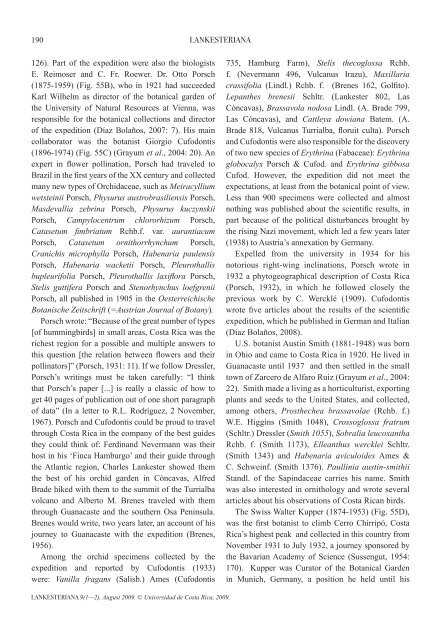orchids and orchidology in central america. 500 ... - lankesteriana.org
orchids and orchidology in central america. 500 ... - lankesteriana.org
orchids and orchidology in central america. 500 ... - lankesteriana.org
You also want an ePaper? Increase the reach of your titles
YUMPU automatically turns print PDFs into web optimized ePapers that Google loves.
190<br />
126). Part of the expedition were also the biologists<br />
E. Reimoser <strong>and</strong> C. Fr. Roewer. Dr. Otto Porsch<br />
(1875-1959) (Fig. 55B), who <strong>in</strong> 1921 had succeeded<br />
Karl Wilhelm as director of the botanical garden of<br />
the University of Natural Resources at Vienna, was<br />
responsible for the botanical collections <strong>and</strong> director<br />
of the expedition (Díaz Bolaños, 2007: 7). His ma<strong>in</strong><br />
collaborator was the botanist Gi<strong>org</strong>io Cufodontis<br />
(1896-1974) (Fig. 55C) (Grayum et al., 2004: 20). An<br />
expert <strong>in</strong> flower poll<strong>in</strong>ation, Porsch had traveled to<br />
Brazil <strong>in</strong> the first years of the XX century <strong>and</strong> collected<br />
many new types of Orchidaceae, such as Meiracyllium<br />
wetste<strong>in</strong>ii Porsch, Physurus austrobrasiliensis Porsch,<br />
Masdevallia zebr<strong>in</strong>a Porsch, Physurus kuczynskii<br />
Porsch, Campylocentrum chlororhizum Porsch,<br />
Catasetum fimbriatum Rchb.f. var. aurantiacum<br />
Porsch, Catasetum ornithorrhynchum Porsch,<br />
Cranichis microphylla Porsch, Habenaria paulensis<br />
Porsch, Habenaria wacketii Porsch, Pleurothallis<br />
bupleurifolia Porsch, Pleurothallis laxiflora Porsch,<br />
Stelis guttifera Porsch <strong>and</strong> Stenorhynchus loefgrenii<br />
Porsch, all published <strong>in</strong> 1905 <strong>in</strong> the Oesterreichische<br />
Botanische Zeitschrift (=Austrian Journal of Botany).<br />
Porsch wrote: “Because of the great number of types<br />
[of humm<strong>in</strong>gbirds] <strong>in</strong> small areas, Costa Rica was the<br />
richest region for a possible <strong>and</strong> multiple answers to<br />
this question [the relation between flowers <strong>and</strong> their<br />
poll<strong>in</strong>ators]” (Porsch, 1931: 11). If we follow Dressler,<br />
Porsch’s writ<strong>in</strong>gs must be taken carefully: “I th<strong>in</strong>k<br />
that Porsch’s paper [...] is really a classic of how to<br />
get 40 pages of publication out of one short paragraph<br />
of data” (In a letter to R.L. Rodríguez, 2 November,<br />
1967). Porsch <strong>and</strong> Cufodontis could be proud to travel<br />
through Costa Rica <strong>in</strong> the company of the best guides<br />
they could th<strong>in</strong>k of: Ferd<strong>in</strong><strong>and</strong> Nevermann was their<br />
host <strong>in</strong> his ‘F<strong>in</strong>ca Hamburgo’ <strong>and</strong> their guide through<br />
the Atlantic region, Charles Lankester showed them<br />
the best of his orchid garden <strong>in</strong> Cóncavas, Alfred<br />
Brade hiked with them to the summit of the Turrialba<br />
volcano <strong>and</strong> Alberto M. Brenes traveled with them<br />
through Guanacaste <strong>and</strong> the southern Osa Pen<strong>in</strong>sula.<br />
Brenes would write, two years later, an account of his<br />
journey to Guanacaste with the expedition (Brenes,<br />
1956).<br />
Among the orchid specimens collected by the<br />
expedition <strong>and</strong> reported by Cufodontis (1933)<br />
were: Vanilla fragans (Salisb.) Ames (Cufodontis<br />
LANKESTERIANA<br />
LANKESTERIANA 9(1—2), August 2009. © Universidad de Costa Rica, 2009.<br />
735, Hamburg Farm), Stelis thecoglossa Rchb.<br />
f. (Nevermann 496, Vulcanus Irazu), Maxillaria<br />
crassifolia (L<strong>in</strong>dl.) Rchb. f. (Brenes 162, Golfito).<br />
Lepanthes brenesii Schltr. (Lankester 802, Las<br />
Cóncavas), Brassavola nodosa L<strong>in</strong>dl. (A. Brade 799,<br />
Las Cóncavas), <strong>and</strong> Cattleya dowiana Batem. (A.<br />
Brade 818, Vulcanus Turrialba, floruit culta). Porsch<br />
<strong>and</strong> Cufodontis were also responsible for the discovery<br />
of two new species of Erythr<strong>in</strong>a (Fabaceae): Erythr<strong>in</strong>a<br />
globocalyx Porsch & Cufod. <strong>and</strong> Erythr<strong>in</strong>a gibbosa<br />
Cufod. However, the expedition did not meet the<br />
expectations, at least from the botanical po<strong>in</strong>t of view.<br />
Less than 900 specimens were collected <strong>and</strong> almost<br />
noth<strong>in</strong>g was published about the scientific results, <strong>in</strong><br />
part because of the political disturbances brought by<br />
the ris<strong>in</strong>g Nazi movement, which led a few years later<br />
(1938) to Austria’s annexation by Germany.<br />
Expelled from the university <strong>in</strong> 1934 for his<br />
notorious right-w<strong>in</strong>g <strong>in</strong>cl<strong>in</strong>ations, Porsch wrote <strong>in</strong><br />
1932 a phytogeographical description of Costa Rica<br />
(Porsch, 1932), <strong>in</strong> which he followed closely the<br />
previous work by C. Wercklé (1909). Cufodontis<br />
wrote five articles about the results of the scientific<br />
expedition, which he published <strong>in</strong> German <strong>and</strong> Italian<br />
(Díaz Bolaños, 2008).<br />
U.S. botanist Aust<strong>in</strong> Smith (1881-1948) was born<br />
<strong>in</strong> Ohio <strong>and</strong> came to Costa Rica <strong>in</strong> 1920. He lived <strong>in</strong><br />
Guanacaste until 1937 <strong>and</strong> then settled <strong>in</strong> the small<br />
town of Zarcero de Alfaro Ruiz (Grayum et al., 2004:<br />
22). Smith made a liv<strong>in</strong>g as a horticulturist, export<strong>in</strong>g<br />
plants <strong>and</strong> seeds to the United States, <strong>and</strong> collected,<br />
among others, Prosthechea brassavolae (Rchb. f.)<br />
W.E. Higg<strong>in</strong>s (Smith 1048), Crossoglossa fratrum<br />
(Schltr.) Dressler (Smith 1055), Sobralia leucoxantha<br />
Rchb. f. (Smith 1173), Elleanthus wercklei Schltr.<br />
(Smith 1343) <strong>and</strong> Habenaria aviculoides Ames &<br />
C. Schwe<strong>in</strong>f. (Smith 1376). Paull<strong>in</strong>ia aust<strong>in</strong>-smithii<br />
St<strong>and</strong>l. of the Sap<strong>in</strong>daceae carries his name. Smith<br />
was also <strong>in</strong>terested <strong>in</strong> ornithology <strong>and</strong> wrote several<br />
articles about his observations of Costa Rican birds.<br />
The Swiss Walter Kupper (1874-1953) (Fig. 55D),<br />
was the first botanist to climb Cerro Chirripó, Costa<br />
Rica’s highest peak <strong>and</strong> collected <strong>in</strong> this country from<br />
November 1931 to July 1932, a journey sponsored by<br />
the Bavarian Academy of Science (Sussengut, 1954:<br />
170). Kupper was Curator of the Botanical Garden<br />
<strong>in</strong> Munich, Germany, a position he held until his
















